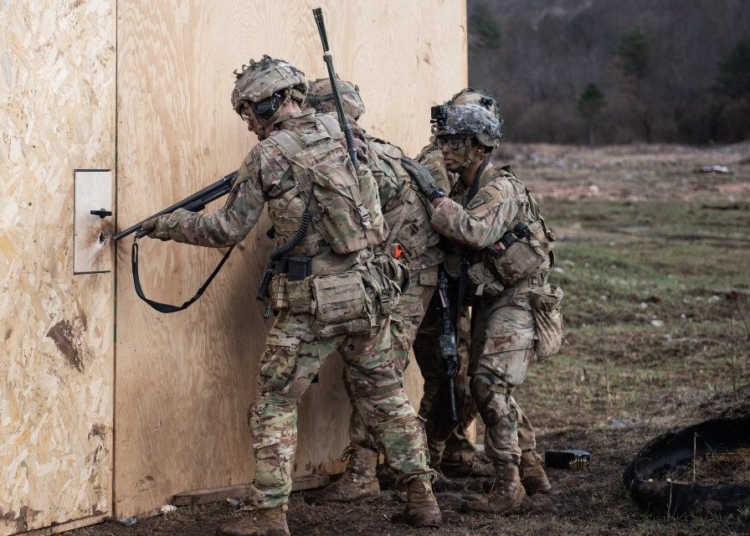This article explores the realities and benefits of tactical simulations in military training. It explains how simulations provide a safe and controlled environment for soldiers to train and refine their skills without the risks of live-fire exercises. The article also discusses the evolution of tactical simulations, highlighting advancements in technology that have made them more realistic and immersive. It outlines the advantages of using simulations in military training, such as reduced risk, cost-efficiency, skill development, scenario customization, and performance evaluation. The article also acknowledges the limitations and challenges of tactical simulations, including technology limitations, environmental limitations, and the need for skilled instructors. Overall, it emphasizes the importance of tactical simulations as a vital tool in modern military training.
Inside the War Room: Exploring the Realities of Tactical Simulations in Military Training
Introduction
Military training has long been an essential component of preparing armed forces for combat. One crucial aspect of this training is the use of tactical simulations, which provide a realistic and immersive environment for soldiers to develop their skills. This article takes an in-depth look at the realities and benefits of tactical simulations in military training.
The Power of Simulation
Tactical simulations replicate real-life combat scenarios, allowing soldiers to train and refine their abilities without the actual risks and potential consequences of live-fire exercises. They create a controlled environment where soldiers can make decisions, experiment with strategies, and learn from the outcomes in a safe and controlled manner.
Simulations provide valuable experience in decision-making under pressure, critical thinking, and adaptability. They help soldiers develop their situational awareness, enhance their problem-solving skills, and learn the importance of teamwork and effective communication.
The Evolution of Tactical Simulations
Tactical simulations have come a long way since their inception. Initially, these simulations were simple tabletop exercises or computer-based games that provided a basic representation of combat scenarios. However, advancements in technology have revolutionized the capabilities of tactical simulations.
Modern simulations utilize state-of-the-art software, virtual reality (VR), and augmented reality (AR) technologies to create incredibly realistic and immersive training environments. High-fidelity graphics, realistic physics engines, and accurate weapon simulations all contribute to an authentic experience for soldiers.
These new technologies also allow for more interactive and dynamic scenarios, including complex urban warfare simulations and large-scale joint-force exercises. By replicating real-world environments and threats, soldiers can train in realistic settings that closely mirror the challenges they may face in actual combat situations.
Benefits of Tactical Simulations
The use of tactical simulations in military training offers several significant benefits, both for individual soldiers and the armed forces as a whole.
Reduced Risk
Tactical simulations provide a safe environment for soldiers to learn and make mistakes without risking injury or loss of life. By conducting repetitive and realistic training scenarios, soldiers can identify and rectify errors, ultimately enhancing their skills and reducing risks during actual combat.
Cost-Efficiency
Traditional military exercises, such as live-fire training, can be prohibitively expensive due to the need for ammunition, equipment, and infrastructure. Tactical simulations significantly reduce these costs, as they mostly rely on software and virtual environments. Additionally, simulations can be easily repeated, allowing soldiers to practice and refine their skills without incurring additional expenses.
Skill Development
Tactical simulations offer a unique opportunity for soldiers to develop and refine their skills in a realistic and repetitive manner. Through constant practice and exposure to challenging scenarios, soldiers can improve their decision-making abilities, enhance their situational awareness, and develop effective communication and teamwork skills.
Scenario Customization
Tactical simulations allow military trainers to create custom scenarios tailored to specific training objectives. Whether it’s urban warfare, counter-terrorism operations, or joint-force exercises, simulations can be customized to replicate the exact conditions soldiers may encounter in the field, ensuring the training is relevant and effective.
Performance Evaluation
Soldiers’ performance in tactical simulations can be meticulously recorded, allowing trainers to evaluate individual and team performance objectively. This data can be used to identify areas of improvement, provide personalized feedback, and develop strategies to enhance unit effectiveness.
Limitations and Challenges
While tactical simulations offer numerous benefits, they also present certain limitations and challenges.
Technology Limitations
As simulations become increasingly sophisticated, the technology required to support them can be costly and complex. High-fidelity graphics, immersive VR or AR systems, and powerful computer hardware are essential for creating realistic training environments. Ensuring access to, and maintaining, this technology can be a logistical challenge for military forces.
Environmental Limitations
Simulations can accurately recreate many aspects of combat scenarios, but they may not fully replicate the complexities of real-world environments. Factors like weather conditions, the unpredictability of human behavior, and the emotional stress of combat cannot be fully replicated, which may limit the realism of training experiences.
Maintaining Realism
It takes skilled instructors and trainers to create and manage realistic tactical simulations. Effective scenario design, dynamic events, and adaptive behaviors of virtual opponents are crucial elements in maintaining the immersion and realism necessary for effective training. Extensive knowledge and expertise are required to ensure simulations accurately reflect the challenges faced by soldiers in real combat situations.
Conclusion
Tactical simulations have become a vital tool in modern military training. They provide a safe, cost-efficient, and realistic training environment that helps soldiers develop crucial skills and prepare for the challenges of real combat. While they may have limitations, the benefits of tactical simulations outweigh the challenges, making them an indispensable component of military training in the 21st century.













